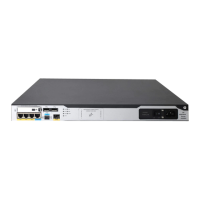43
Figure 16 Changing an RPF route
As shown in Figure 16, when no static multicast route is configured, Router C's RPF neighbor on the path
back to the source is Router A. The multicast data from the source travels through Router A to Router C.
You can configure a static multicast route on Router C and specify Router B as Router C's RPF neighbor
on the path back to the source. The multicast data from the source travels along the path: Router A to
Router B and then to Router C.
Creating an RPF route
When a unicast route is blocked, multicast forwarding might be stopped due to lack of an RPF route. You
can configure a static multicast route to create an RPF route. In this way, a multicast routing entry is
created to guide multicast forwarding.
Figure 17 Creating an RPF route
As shown in Figure 17, the RIP domain and the OSPF domain are unicast isolated from each other. When
no static multicast route is configured, the receiver hosts in the OSPF domain cannot receive the multicast
packets from the multicast source in the RIP domain. You can configure a static multicast route on Router
GE1/0/1
1.1.1.2/24
GE1/0/2
1.1.1.1/24
GE1/0/2
2.2.2.2/24
GE1/0/1
2.2.2.1/24
Source
192.168.0.1/24
Source/Mask
Multicast Routing Table Static on Router C
192.168.0.0/24
Interface
GE1/0/1
RPF neighbor/Mask
1.1.1.1/24
Source/Mask
Multicast Routing Table Static on Router D
192.168.0.0/24
Interface
GE1/0/1
RPF neighbor/Mask
2.2.2.2/24
OSPF domain
RIP domain
Router A Router B Router C
Router D
Receiver
Receiver
Multicast packets Multicast static route

